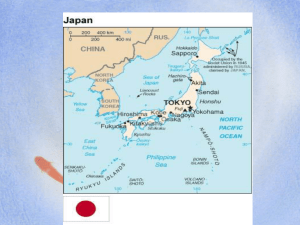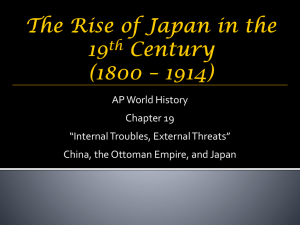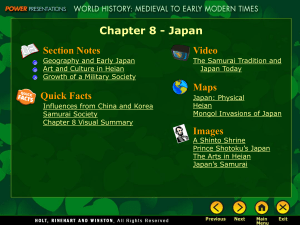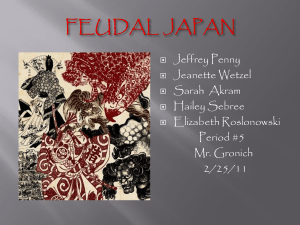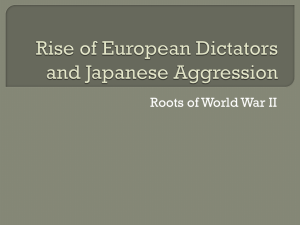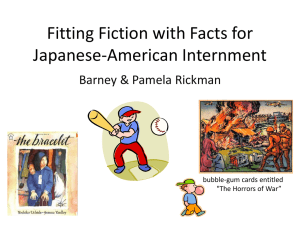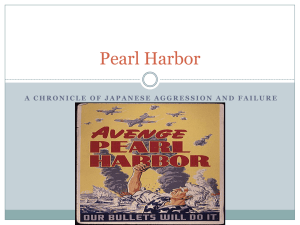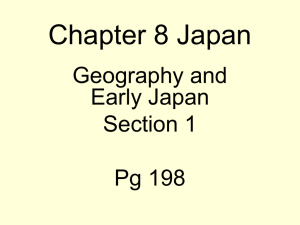Japan
advertisement
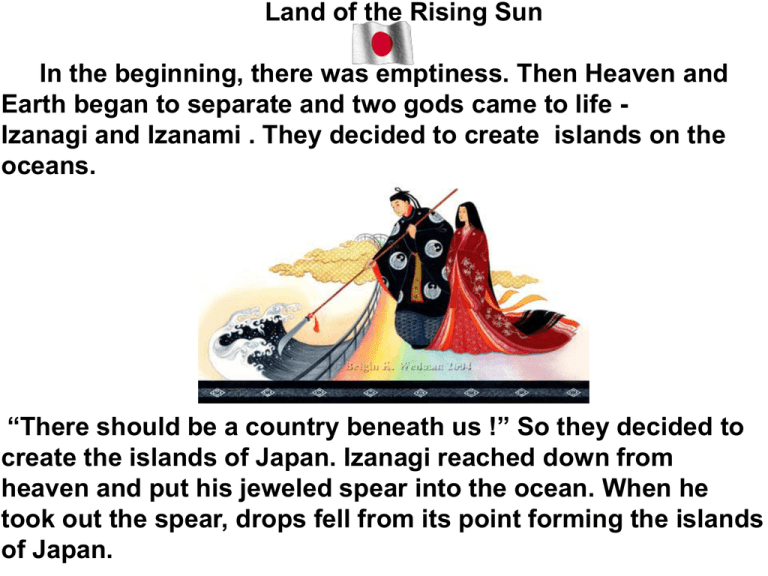
Land of the Rising Sun In the beginning, there was emptiness. Then Heaven and Earth began to separate and two gods came to life Izanagi and Izanami . They decided to create islands on the oceans. “There should be a country beneath us !” So they decided to create the islands of Japan. Izanagi reached down from heaven and put his jeweled spear into the ocean. When he took out the spear, drops fell from its point forming the islands of Japan. This is how the world began, according to Japanese mythology. Then the two gods decided to create a new god - the Sun Goddess, who was called Amaterasu. The Sun Goddess gave life to everything around her. The Sun Goddess sent her grandson, Ninigi to take control of the Japanese island of Honshu. To make sure the people would accept him, she sent with him her bronze mirror, her jewel and a great iron sword. Eventually Ninigi’s grandson, Jimmu, became the first emperor of the Japanese people. Today, the objects in the legend--the mirror, the jewel, and the sword are the symbols of the emperor’s godly power. Many years ago, volcanos pushed up out of the Pacific Ocean. The tops of these mountains are the islands of Japan. The Japanese islands are very unstable . Each year Japan has over 1,500 earthquakes, most are minor . And 60 volcanoes are still active. Most of Japan is mountains and hills. There is very little farmland. The sea has always been Japan’s greatest help - it provides most of their food ! Japan’s seas are also a natural barrier, keeping Japan in isolation, or setting it an apart from much of the world. Because it was an island nation, the Japanese developed their own culture, (traditions, beliefs, values, attitudes, religion, their own way of living.) 1. What was a result of Japan being an island nation? A. The Japanese were able to develop their own culture B. They were invaded by Korea C. They were invaded by China D. The Japanese were separated from other Africans The Early People of Japan In the early history of Japan many people came there. One of the first people were hunter-gatherers called Ainu, The Ainu still live on the island of Hokkaido. Later, people from Korea and Indonesia, and northern Asia came to Japan. The people who became the Japanese lived in small farming villages ruled by powerful clans or families. People outside of a family or clan had to obey and respect the members of the clan and their chief. Some clans became very powerful and ruled an entire area of Japan, like a family - owned state within the country. Each of these sections of Japan is controlled by a family or clan All these Japanese clan – states are similar to another type of government you learned about in the 6th grade --The City-States of GREECE !! 2. Early Japanese society under the clans was not a single unified country but many small states. This type of government most resembles that of A. the early city-states of ancient Greece B. the Roman Empire during the Pax Romana C. the Old Kingdom of ancient Egypt D. the New Kingdom of ancient Egypt *SHINTOISM The religion of early Japan was called SHINTO. It worshipped nature and teaches that the world is filled with divine spirits called kami. The highest kami, the Sun Goddess, was believed to be the ancestor of Japan’s emperor. * Japanese Prince Shotoku ruled Japan. He travelled in China and was very impressed with Chinese ways including the religion of BUDDHISM. 3. How did Prince Shotoku learn about Chinese society and culture? A. He travelled in China B. He sent scholars to China C. He studied with Confucius D. He studied Shintoism Buddhism had spread from India to China and into Korea. So, In the early 600's AD Prince Shotoku had Buddhist priests sent to Japan. Japanese liked Buddhism because it promised rewards if you were faithful and good. 4. What did Japan learn from Korea? A. written language B. Confucianism C. Buddhism D. spoken language Prince Shotoku also brought Confucianism from China to Japan which taught people how to behave and gave rules for families. The Chinese emperors had great power. Prince Shotoku wanted Japan’s emperors to have great power too. The Japanese did not have a written language. So, they copied Chinese writing. 5. The influence of China and Korea on Japan’s history, culture, and development is found in all of the following except A. Japan’s first writing system B. the Japanese religion of Shinto C. early rules for family behavior D. the practice of Buddhism 6. What did Japan learn from China? A. Korean Language B. Spoken language C. Sign language D. written language 7. China influenced medieval Japan by Japan’s development of A. a writing system B. the samurai tradition C. haiku poetry D. a civil service exam In 710, the Japanese created a capital called Nara in the excellent farmland on Honshu. Religion and art became very important in Nara. But 84 years later the Emperor and his family set up a new capital in Heian (Hay-ahn) which later was renamed Kyoto. The finely dressed women and men of the Emperor's court lived in the new capital of Kyoto, a life of luxury. In Heian (Kyoto) Japan enjoyed a time called the Golden Age of Japan. Wealthy nobles at the emperor’s court paid for and helped create beautiful art, Drama (called Noh drama) fancy writing called Calligraphy and architecture (buildings ) copied from the Chinese 8. Which Japanese art was modeled on Chinese styles? A. Architecture B. drama C. novels D. prose and literature. Japanese learned to write using the Chinese language, and wealthy noble men wrote stories and poems in the language of the court – Chinese. But women wrote in Japanese (which used the Chinese symbols for Japanese sounds). FATHER in Japanese Women wrote stories, poems, and diaries about their lives in the Emperor’s court. As a result, some of the greatest works of early Japanese literature are by women ! 9. Most great works of early Japanese literature were written by A. Buddhist scholars C. Shinto priests B. samurai warriors D. noble women Lady Murasaki Shikibu was a noble woman who described in her diary what she saw in the Emperor’s court. She also wrote what may be history’s first novel called “the Tale of Genji” about a prince named Genji who is looking for love. The book tells us what the attitudes and customs were like in ancient Japan. “I was brought up in a distant province which lies farther than the farthest end of the Eastern Road. I am ashamed to think that inhabitants of the Royal City will think me an uncultured girl. Somehow I came to know that there are such things as romances in the world and wished to read them. When there was nothing to do by day or at night, one tale or another was told me by my elder sister or stepmother and I heard several chapters about the shining Prince Genji.” 10. From the content of this passage, it can be concluded that its author was a A. samurai warrior B. noble woman from Heian C. farmer from northern Japan D. daimyo The Japanese nobles of Heian (Kyoto) valued art and learning just like another group of people you learned about in the 6th grade - The people of Athens, Greece ! 11. The nobles of Heian placed great emphasis on art and learning, just like the people of which ancient Greek city-state that you learned about in Grade 6 ? A. Sparta B. Athens C. Macedonia D. Troy During the Heian period, Buddhism was popular and many new forms were created – such as Pure Land Buddhism and Zen. The common people enjoyed Pure Land Buddhism because it promised a paradise for chanting Buddha’s name over and over. Zen Buddhism was popular with samurai warriors because it valued self discipline. 12. Zen became popular among A. Pure Land Buddhists B. Common people C. The Chinese D. Samurai Zen Buddhism taught that physical and mental exercise would produce a sudden understanding of all things. These are all examples of Zen Buddhism: The tea ceremony practices the quiet appreciation for the tea, the room with its sounds and smells, the people and good manners, and calm and friendly conversation. The Japanese garden is a calm place for meditation and where people appreciate nature. Flower arranging (called Ikebana) teaches balance in nature and beauty. and Zen also encouraged painting. Calligraphy taught the careful, self control of artistic writing. Geisha, meaning “Artist”, is another example of Zen. Women study dance, music, poetry, and literature to entertain people. Another way to practice Zen is the SUMO wrestler ! It takes great concentration and self discipline to be a SUMO. The court life of the Emperor was quite different from the rest of Japan. In the country and towns of Japan, nobles were fighting each other. These nobles were called DAIMYO’s . They were wealthy landowners. To protect their lands, or take over other lands, they hired trained professional warriors called samurai, which means “those who serve.” 13. Daimyo were A. trained professional warriors B. military rulers C. figureheads D. wealthy landowners 14. Which statement accurately describes the relationship of a samurai to a daimyo? A. Daimyo hired samurai to defend them and their property. B. Samurai hired daimyo to defend them and their property. C.Daimyo paid samurai in slaves. D. Daimyo had to obey every command of their samurai lord. After years of fighting, one Daimyo became the most powerful. He took the title of SHOGUN. He was the military ruler of Japan. The emperor was not removed, but he became a “figurehead” (one who looks powerful, but has little real power). Prince Shotoku’s desire for strong Japanese emperors had not been successful. Shoguns would rule Japan for hundreds of years. Here you see the levels of society created during this time. 15. Which term means a military ruler? A. daimyo B. bushido C. shogun D. samurai 16. Which of Prince Shotoku’s plans did not succeed ? A. To make the Japanese emperor more powerful B. To make Buddhism more widespread C. To increase the number of people who practiced Shintoism D. To learn about Confucianism *As powerful as the Shogun was, the Daimyo were nearly as powerful because the Daimyo owned large amounts of land , controlled nearly all the peasants, and paid the Samurai warriors. 17. Daimyos became nearly as powerful as the shoguns by: A. killing the shogun B. controlling most of the peasants and farmland C. freeing samurai to work for the shogun D. none of these honor and discipline . This code was called “BUSHIDO”. There main job was to defend lords with their most important possession – the samurai sword. Samurai had great endurance (strength) great physical skill (fighting abilities), and great courage. Today, in modern Japan, the samurai qualities of loyalty, honor and discipline are still taught to children and valued in society. 18. Which statement is not true about the code of bushido? A. It was followed by samurai B. It was created by the emperor C. It is honored in Japanese society today D. It calls for very strict discipline 19. A samurai’s most important possession was A. his Daimyo B. his sword C. his helmet D. his land 20. Endurance, cunning, physical strength and courage were the ideal characteristics of A. Confucian officials B. Buddhist priests C. Japanese samurai D. Hindu governors 21. The importance of loyalty, honor, and discipline in Japanese society today are mainly the result of what influence in Japan’s history? A. the code of the samurai D. the spread of Chinese Buddhism B. the teachings of Shinto C. the reforms of Prince Shotoku 22. The main function of samurai in Japanese society was to A. write poetry B. manage farmland C. defend lords D. conquer China The Impact of Foreign Invasion For many years Japan traded peacefully with China. In the late 1200s, however, Japan received an unusual offer . The Mongols, led by Kublai Khan, had taken over China and now they wanted to rule Japan as well. Kublai Khan sent a message to the Japanese “Join my empire and be ruled by me !” When the Japanese said "No", the Mongols attacked Japan. In 1274 the Mongols sent 25,000 soldiers on hundreds of ships from Korea across the Sea of Japan, but most of the soldiers drowned because of a terrible storm at sea. In 1281, the Mongols tried again. This time they sent over 4,000 ships with 150,000 soldiers. They landed on the island of Kyushu. The Mongols used crossbows that shot farther than Japanese arrows, and catapults that hurled flaming bombs. But the samurai, trusting in their swords, fought fiercely. After 50 days of battle, another powerful typhoon helped the Japanese. The winds and rains destroyed the Mongol ships. The Japanese called the storm "kamikaze" or “divine wind,” believing that their gods had helped them. Foreigners in Japan When Portuguese traders reached Japan in 1542, they brought something new to Japan – GUNS ! These weapons were far superior to swords and arrows. The shogun, Nobunaga, armed his warriors with these new weapons and soon took control of more than a third of the country. But the Portuguese also brought Catholic missionaries to spread Christianity to the Japanese. By the early 1600’s the shoguns saw these foreigners as a threat. These were the problems they saw: 1. Europe was always at war and they were afraid these European wars might spread to Japan. 2. They were afraid Japanese Christians would obey the Pope in Rome instead of the shogun. 3. Because of all the new trade with Europe, the shogun was afraid that daimyo would became rich and take over the government . 4. They did not like new European customs : smoking tobacco, and new kinds of music. gambling, So, Between 1612 and 1635, the shogun created laws that Christianity was no longer allowed and all Christians must leave Japan or be killed. Japan decided to isolate itself from everything that was western . People were not allowed to travel and almost all European trade was stopped. The islands of Japan were off limits to other countries. New ideas, inventions, art, the entire history of other countries went on for 200 years without touching the Japanese people. But inside Japan, arts and literature, music and theatre, and appreciation for beauty became important. All this was possible because the rule of the shoguns was so strong that wars and rebellions stopped and Japan was at peace. Many countries tried to get Japan to enter the modern age and begin trading with them. In 1853 President Millard Fillmore of the United States finally sent several warships led by Commodore Matthew Perry which forced Japan to accept trade with America. They were soon convinced to make a trade treaty with the Americans and soon after with the rest of the world. Japan's isolation was over for ever ! And the world was eager to learn more about this beautiful hidden country with its unique customs and long history. Today ALL the world trades with Japan !
